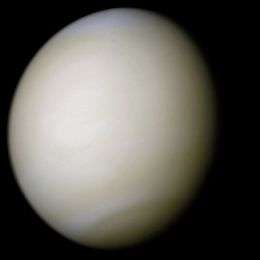2013 ND15
| Discovery | |
|---|---|
| Discovered by | Pan-STARRS |
| Discovery date | July 13, 2013 |
| Designations | |
| MPC designation | 2013 ND15 |
|
Aten asteroid [1][2] Mercury crosser Venus crosser Earth crosser | |
| Orbital characteristics [2][3][4] | |
| Epoch 13 January 2016 (JD 2457400.5) | |
| Uncertainty parameter 7 | |
| Aphelion | 1.1660 AU (174.43 Gm) |
| Perihelion | 0.28100 AU (42.037 Gm) |
| 0.72351 AU (108.236 Gm) | |
| Eccentricity | 0.61162 |
| 0.62 yr (224.8 d) | |
| 198.82° | |
| 1.6015°/day | |
| Inclination | 4.7962° |
| 95.841° | |
| 19.697° | |
| Earth MOID | 0.00751978 AU (1,124,943 km) |
| Jupiter MOID | 3.95146 AU (591.130 Gm) |
| Physical characteristics | |
| Dimensions | 40–100 m[a][5] |
| 24.1[2] | |
|
| |
2013 ND15 (also written 2013 ND15) is an asteroid that is a temporary trojan of Venus, the first known Venus trojan.[6]
Discovery, orbit and physical properties
2013 ND15 was discovered on July 13, 2013 by N. Primak, A. Schultz, T. Goggia and K. Chambers observing for the Pan-STARRS project. As of September 2014, it has been observed 21 times with a data-arc span of 26 days. It is an Aten asteroid and its semi-major axis (0.7235 AU) is very similar to that of Venus but it has high eccentricity (0.6115) and small orbital inclination (4.794°). With an absolute magnitude of 24.1, it has a diameter in the range 40–100 m (for an assumed albedo range of 0.04-0.20).
Trojan dynamical state and orbital evolution
2013 ND15 has been identified as a Venus trojan following a tadpole orbit around Venus' Lagrangian point L4.[6] Besides being a Venus co-orbital, this asteroid is also a Mercury crosser and an Earth crosser. 2013 ND15 exhibits resonant (or near-resonant) behavior with Mercury, Venus and Earth.[6] Its short-term dynamical evolution is different from that of the other three Venus co-orbitals, 2001 CK32, 2002 VE68, and 2012 XE133.[6]
Potentially hazardous asteroid
2013 ND15 is not included in the Minor Planet Center list of potentially hazardous asteroids (PHAs) because its absolute magnitude is greater than 22.0, even though it comes to within 0.05 AU of Earth periodically. It has approached Earth at 0.077 AU on June 21, 2016.
See also
Notes
- ^ This is assuming an albedo of 0.20–0.04.
References
- ↑ List Of Aten Minor Planets
- 1 2 3 "2013 ND15". JPL Small-Body Database. Jet Propulsion Laboratory. SPK-ID: 3645042. Retrieved 3 April 2016.
- ↑ AstDys-2 on 2013 ND15 Retrieved 2014-01-21
- ↑ NEODyS-2 on 2013 ND15 Retrieved 2014-01-21
- ↑ Absolute-magnitude conversion table (H)
- 1 2 3 4 de la Fuente Marcos, C.; de la Fuente Marcos, R. "Asteroid 2013 ND15: Trojan companion to Venus, PHA to the Earth". Monthly Notices of the Royal Astronomical Society. 439 (3): 2970–2977. arXiv:1401.5013
 . Bibcode:2014MNRAS.439.2970D. doi:10.1093/mnras/stu152.
. Bibcode:2014MNRAS.439.2970D. doi:10.1093/mnras/stu152.
- Further reading
- Understanding the Distribution of Near-Earth Asteroids Bottke, W. F., Jedicke, R., Morbidelli, A., Petit, J.-M., Gladman, B. 2000, Science, Vol. 288, Issue 5474, pp. 2190–2194.
- A Numerical Survey of Transient Co-orbitals of the Terrestrial Planets Christou, A. A. 2000, Icarus, Vol. 144, Issue 1, pp. 1–20.
- Debiased Orbital and Absolute Magnitude Distribution of the Near-Earth Objects Bottke, W. F., Morbidelli, A., Jedicke, R., Petit, J.-M., Levison, H. F., Michel, P., Metcalfe, T. S. 2002, Icarus, Vol. 156, Issue 2, pp. 399–433.
- Transient co-orbital asteroids Brasser, R., Innanen, K. A., Connors, M., Veillet, C., Wiegert, P., Mikkola, S., Chodas, P. W. 2004, Icarus, Vol. 171, Issue 1, pp. 102–109.
- The population of Near Earth Asteroids in coorbital motion with Venus Morais, M. H. M., Morbidelli, A. 2006, Icarus, Vol. 185, Issue 1, pp. 29–38.
- Asteroid 2013 ND15: Trojan companion to Venus, PHA to the Earth de la Fuente Marcos, C., de la Fuente Marcos, R. 2013, Monthly Notices of the Royal Astronomical Society, Vol. 439, Issue 3, pp. 2970–2977.
External links
- Discovery MPEC
- 2013 ND15 data at MPC
- List of Potentially Hazardous Asteroids (PHAs)
- 2013 ND15 at the JPL Small-Body Database

